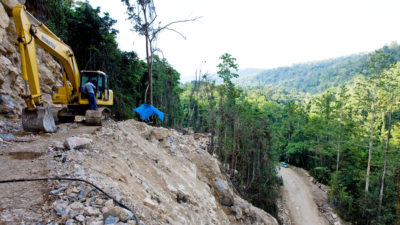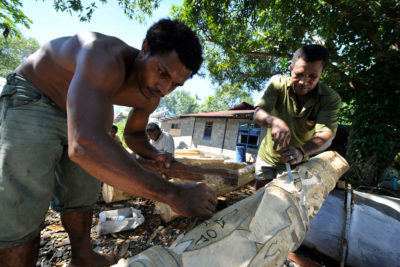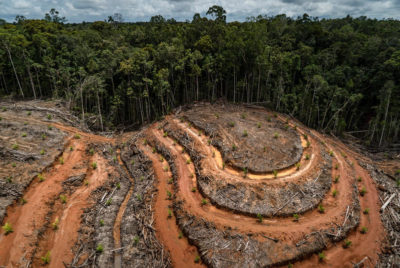
The Indonesian military clears trees for a segment of the Trans-Papua Highway in northern Papua.
Daniel Beltrá / Greenpeace
Opinion
A Highway Megaproject Tears at the Heart of New Guinea’s Rainforest
The Indonesian government is building a 2,700-mile road network
on the island of New Guinea, opening up some of the world’s last great
tropical rainforests to development and threatening unique indigenous
cultures. Can international pressure force Indonesia to scale back this
megaproject?
The Pacific island of New Guinea, which harbors one of the world’s
largest and most intact tropical rainforests, is the epicenter of
Australasia’s tropical biodiversity. The island’s unique denizens,
including tree-kangaroos and birds of paradise, are representative of a
regional flora and fauna so fantastically diverse that Charles Darwin
once mused such creatures must have been made by a “separate Creator.” Today, researchers are still merely sampling its primeval intricacies.
New Guinea is also among the most culturally and linguistically diverse places on earth, with human populations that are genetically distinct from all others alive today. Not until the 1930s did the Western world discover many hundreds of unique indigenous societies in New Guinea’s vast mountains and highlands. And only in the 1950s did European colonists, miners, and loggers begin to exploit the region.
Today, these unique rainforests are being carved up by a massive, ill-advised, and exceptionally risky road-building scheme. The Trans-Papua Highway will sprawl like a massive spiderweb over much of the Indonesian-ruled, western half of New Guinea, known as Papua or West Papua. Totalling 2,700 miles in length, this highway network will penetrate deeply into densely forested or remote mountainous regions to increase access to minerals, fossil fuels, timber, and land for agri-business ventures, including vast palm oil plantations. Many road segments will traverse precariously steep, virgin terrain.
Recent analyses conducted by my research team suggest major new hotspots of deforestation will be created by the roads, along with sharp increases in forest fragmentation, biodiversity loss, and greenhouse-gas emissions.
New Guinea is also among the most culturally and linguistically diverse places on earth, with human populations that are genetically distinct from all others alive today. Not until the 1930s did the Western world discover many hundreds of unique indigenous societies in New Guinea’s vast mountains and highlands. And only in the 1950s did European colonists, miners, and loggers begin to exploit the region.
Today, these unique rainforests are being carved up by a massive, ill-advised, and exceptionally risky road-building scheme. The Trans-Papua Highway will sprawl like a massive spiderweb over much of the Indonesian-ruled, western half of New Guinea, known as Papua or West Papua. Totalling 2,700 miles in length, this highway network will penetrate deeply into densely forested or remote mountainous regions to increase access to minerals, fossil fuels, timber, and land for agri-business ventures, including vast palm oil plantations. Many road segments will traverse precariously steep, virgin terrain.
Recent analyses conducted by my research team suggest major new hotspots of deforestation will be created by the roads, along with sharp increases in forest fragmentation, biodiversity loss, and greenhouse-gas emissions.
The areas circled are projected to experience intense deforestation when the Trans-Papua Highway is completed.
Courtesy of William Laurance
Work on the Trans-Papua Highway has proceeded in fits and starts
since 2013. Nearly nine-tenths of the total road route has been
bulldozed, but the project is far from complete, with much road paving,
earthworks, and hundreds of bridges — totaling more than 4 miles in
length — yet to be constructed.
The most difficult terrain has yet to be traversed, leaving the road network fragmented and discontinuous. The government says the Trans-Papua Highway will bring jobs, badly needed infrastructure, and improved living standards to the people of the region. But many indigenous Papuans fear that the highway will primarily benefit agribusiness and mining interests, as well as large numbers of settlers from other parts of Indonesia. Work on the highway is currently suspended because of a deadly attack on road workers last month.
In political terms, New Guinea is deeply schizophrenic. Its eastern half comprises the nation of Papua New Guinea — a loosely governed state where indigenous groups have well-established legal rights to their traditional lands. Indonesian-ruled Papua is another story. Since assuming control in the 1960s, Indonesia’s Jakarta-based government has pursued two goals: exploiting Papua’s resources while consolidating top-down control. Both objectives have been advanced by vast logging, mining, oil palm, and agri-industrial projects that have flattened tens of millions of acres of forest — often while running roughshod over the land claims of its indigenous peoples.
The most difficult terrain has yet to be traversed, leaving the road network fragmented and discontinuous. The government says the Trans-Papua Highway will bring jobs, badly needed infrastructure, and improved living standards to the people of the region. But many indigenous Papuans fear that the highway will primarily benefit agribusiness and mining interests, as well as large numbers of settlers from other parts of Indonesia. Work on the highway is currently suspended because of a deadly attack on road workers last month.
In political terms, New Guinea is deeply schizophrenic. Its eastern half comprises the nation of Papua New Guinea — a loosely governed state where indigenous groups have well-established legal rights to their traditional lands. Indonesian-ruled Papua is another story. Since assuming control in the 1960s, Indonesia’s Jakarta-based government has pursued two goals: exploiting Papua’s resources while consolidating top-down control. Both objectives have been advanced by vast logging, mining, oil palm, and agri-industrial projects that have flattened tens of millions of acres of forest — often while running roughshod over the land claims of its indigenous peoples.
The construction of this extensive road system spells the beginning of the end for expansive wild areas in Papua.
But as bad as Indonesia’s exploitation of Papua’s priceless forests
has been to date, the Trans-Papua Highway is bringing a whole new level
of destruction, essentially tearing the heart out of a damaged but not
yet decimated tropical paradise. Among the worst impacts of the
Trans-Papua Highway will be three major new deforestation hotspots. One
of these, in central Papua, will abut the world-famous Lorentz National Park, a World Heritage Site, bringing forest disruption right into the park. Lorentz is a global jewel, recently ranked 13th out of more than 173,000 protected areas worldwide in terms of its biological uniqueness and irreplaceability.
Lorentz is so highly valued because of its rare Australasian biodiversity, its size (at over 900,000 square miles it is the largest protected area in Southeast Asia), and its massive elevational and geological variety; the park stretches from the southern coast and lowland rainforests to the snow-capped peaks of Papau’s central mountain range. As a result, Lorentz should be relatively resilient to climate change because species could migrate along its varied elevations and find local refuges during droughts or other extreme events.
The park’s biodiversity is renowned, harboring 80 percent of Papua’s native mammals, two designated endemic bird areas, 34 distinct vegetation types, and many relict species of great evolutionary significance dating to the time more than 180 million years ago when all the Southern Hemisphere’s landmasses were joined in the supercontinent, Gondwana.
As part of the Trans-Papua Highway, roughly 120 miles of new roads will cut across Lorentz, greatly increasing human access to 124,000 acres of designated mining concessions inside the park. In environmental terms, this is a giant red flag: Indonesia has a long history of downgrading or downsizing its protected areas to allow access to minerals, timber, or other resources. Increased roads inside Lorentz will surely intensify pressures to exploit the park and its adjoining forests.
Lorentz is so highly valued because of its rare Australasian biodiversity, its size (at over 900,000 square miles it is the largest protected area in Southeast Asia), and its massive elevational and geological variety; the park stretches from the southern coast and lowland rainforests to the snow-capped peaks of Papau’s central mountain range. As a result, Lorentz should be relatively resilient to climate change because species could migrate along its varied elevations and find local refuges during droughts or other extreme events.
The park’s biodiversity is renowned, harboring 80 percent of Papua’s native mammals, two designated endemic bird areas, 34 distinct vegetation types, and many relict species of great evolutionary significance dating to the time more than 180 million years ago when all the Southern Hemisphere’s landmasses were joined in the supercontinent, Gondwana.
As part of the Trans-Papua Highway, roughly 120 miles of new roads will cut across Lorentz, greatly increasing human access to 124,000 acres of designated mining concessions inside the park. In environmental terms, this is a giant red flag: Indonesia has a long history of downgrading or downsizing its protected areas to allow access to minerals, timber, or other resources. Increased roads inside Lorentz will surely intensify pressures to exploit the park and its adjoining forests.
Papuan tribesmen carve a traditional wooden pole. The Trans-Papua Highway will cut through the lands of many indigenous tribes.
Romeo Gacad / AFP / Getty Images
As is always the case, the construction of an extensive road system
spells the beginning of the end of these wild areas as roads open the
way for illegal deforestation, poaching, wildfires, and land investors
bent on encouraging a building boom. Unfortunately, the Trans-Papua
Highway is just one small part of a global tsunami of infrastructure
expansion. By 2050, the earth could accumulate another 15 million miles
of paved roads, according to the International Energy Agency
— enough to circle the planet more than 600 times. Around nine-tenths
of all new infrastructure is slated for developing nations, which are
home to nearly all of the world’s tropical and subtropical forests.
As part of its development scheme for Papua, Indonesia has used a massive transmigration program
to attract upwards of a million settlers to Papua from elsewhere in
Indonesia. Most settlers are aligned with Indonesia’s Muslim-majority
rulers, and so have been ceded large land holdings and many economic and
political opportunities. This has ignited conflicts between the
migrants and indigenous Papuans — tensions that are palpable today.
Papuan independence and protest movements flare up sporadically, but are
heavily suppressed by the Indonesian police and military.
In addition to the Trans-Papua Highway’s incursion into Lorentz National Park, a second deforestation hotspot is in southeastern Papua, an area with extensive lowland forests and vast tropical peatlands that have built up over thousands of years. The habitat complexity and species diversity of this region is remarkable, with rainforests, towering wet-sclerophyll forests, riparian forests, peatlands, and mangroves all comprising some of the world’s great remaining intact forest landscapes.
The high prevalence of acid-sulfate soils makes it an economic calamity for most crops, but that has not stopped Indonesia’s central government from undertaking wildly ambitious schemes, such as a massive rice and oil palm venture that could span 4 million acres. If these schemes proceed, toxic runoff from acid-sulfate soils, fertilizers, pesticides, and gold mining could devastate some of the world’s richest coral reefs and coastal fisheries just offshore.
In addition to the Trans-Papua Highway’s incursion into Lorentz National Park, a second deforestation hotspot is in southeastern Papua, an area with extensive lowland forests and vast tropical peatlands that have built up over thousands of years. The habitat complexity and species diversity of this region is remarkable, with rainforests, towering wet-sclerophyll forests, riparian forests, peatlands, and mangroves all comprising some of the world’s great remaining intact forest landscapes.
The high prevalence of acid-sulfate soils makes it an economic calamity for most crops, but that has not stopped Indonesia’s central government from undertaking wildly ambitious schemes, such as a massive rice and oil palm venture that could span 4 million acres. If these schemes proceed, toxic runoff from acid-sulfate soils, fertilizers, pesticides, and gold mining could devastate some of the world’s richest coral reefs and coastal fisheries just offshore.
Last month, anti-government rebels killed nearly two-dozen road workers along the Trans-Papua Highway.
Globally, the burning and decomposition of carbon-rich peatlands is
one of the largest sources of greenhouse gas emissions from land use
change. In Indonesia, peat fires also generate most of the choking haze
that has repeatedly plagued much of Southeast Asia, forcing widespread
closures of schools and airports and sharp increases in respiratory
distress. One study suggests that haze from Indonesian fires could have
caused the premature deaths of more than 100,000 people in 2015 alone.
Indonesian President Joko Widodo has pledged to reduce haze, but it is
difficult to imagine how this will be achieved if massive peat-fires in
Papua are added to peatlands burning in Sumatra and Indonesian Borneo.
The southern crowned pigeon is among the globally threatened species found in Papua's Lorentz National Park.
Luc Viatour / Wikimedia Commons
The third deforestation hotspot is in central-eastern Papua, and will
consume some of its most remote and least explored ecosystems. These
include both lowland forests and high-altitude cloud forests, as well as
alpine regions that are bastions for relict Gondwanan species, such as
marsupials, cassowaries, and many archaic plants. The region also is
home to diverse indigenous peoples. By slicing through the traditional
lands of so many different indigenous groups, especially in the remote
highlands, the new roads will almost certainly provoke anti-government
sentiment.
Last month, anti-government rebels killed nearly two dozen road workers along a stretch of the Trans-Papua Highway in eastern Papua. The rebels, affiliated with a militant wing of the Free Papua Movement, say that more attacks are coming, while the Indonesian police and military are promising rapid reprisals. Indonesia has 54,000 square miles of customary land claims currently under review, but virtually none are in Papua, indicating just how poorly the Indonesian government has treated traditional Papuan land rights.
Last month, anti-government rebels killed nearly two dozen road workers along a stretch of the Trans-Papua Highway in eastern Papua. The rebels, affiliated with a militant wing of the Free Papua Movement, say that more attacks are coming, while the Indonesian police and military are promising rapid reprisals. Indonesia has 54,000 square miles of customary land claims currently under review, but virtually none are in Papua, indicating just how poorly the Indonesian government has treated traditional Papuan land rights.
The
Trans-Papua Highway will open up vast areas of previously untouched
forest for palm oil plantations, such as this one in eastern Papua.
Ulet Ifansasti / Greenpeace
Given the resentments against Indonesia’s heavy-handed rule, massive
road building across Papua’s remote indigenous lands could be like
dousing a fire with gasoline. It is often assumed that people living in
remote regions welcome new roads, but in fact opinions are deeply
divided, says Selwyn Moran, an indigenous social activist who lives in
southeastern Papua. “Papuans feel roads are something you ought to be
grateful for, but they fear the militarization, non-Papuan migrants who
assume dominant roles, and extractive industries” that come with roads,
Moran said.
As an analysis by my colleagues and I has shown, the Trans-Papua Highway rests on shaky financial foundations. The Indonesian government has invested tens of billions of dollars in the network, but the project has yet to surmount the most challenging terrain. Road construction in high-rainfall tropical environments is notoriously expensive, especially in steep or swampy areas where extensive bridges, culverts, and heavy earthworks are required. The planned road segments just in Lorentz National Park will require more than 50 separate bridges.
In addition to large capital costs, maintenance costs for roads in steep or high-rainfall environments are notoriously high — estimated at around 20 percent of the total road-construction cost per year by World Bank experts in Papua. And without concerted maintenance, expensive roads can quickly be rendered useless by landslides, potholes, and fissures. Further, in many developing nations, corruption in construction industries is so rife that up to half of all funding can be squandered by misappropriation and shoddy construction practices.
As an analysis by my colleagues and I has shown, the Trans-Papua Highway rests on shaky financial foundations. The Indonesian government has invested tens of billions of dollars in the network, but the project has yet to surmount the most challenging terrain. Road construction in high-rainfall tropical environments is notoriously expensive, especially in steep or swampy areas where extensive bridges, culverts, and heavy earthworks are required. The planned road segments just in Lorentz National Park will require more than 50 separate bridges.
In addition to large capital costs, maintenance costs for roads in steep or high-rainfall environments are notoriously high — estimated at around 20 percent of the total road-construction cost per year by World Bank experts in Papua. And without concerted maintenance, expensive roads can quickly be rendered useless by landslides, potholes, and fissures. Further, in many developing nations, corruption in construction industries is so rife that up to half of all funding can be squandered by misappropriation and shoddy construction practices.
The Trans-Papua Highway’s many harmful effects and dubious financial foundations make it an exceptionally risky venture.
My concerns asbout the Trans-Papua Highway are shared by a growing
number of scientists and environmental and indigenous rights groups in
Indonesia and internationally. My hope is that this opposition will
snowball as Papua’s development controversies increase.
The fact is that the Trans-Papua Highway’s many harmful effects and dubious financial foundations make it an exceptionally risky venture for national and international investors. Indonesian and Chinese interests are prevalent, and as history has shown, they often have a dismal environmental track record. But the entire world, including many Western corporations, consume minerals, timber, palm oil, and other agribusiness products from Papua. This is one area where conservation and non-profit groups can have some leverage over the Indonesian government as efforts grow to scale back the negative environmental and social impacts of the highway.
The fact is that the Trans-Papua Highway’s many harmful effects and dubious financial foundations make it an exceptionally risky venture for national and international investors. Indonesian and Chinese interests are prevalent, and as history has shown, they often have a dismal environmental track record. But the entire world, including many Western corporations, consume minerals, timber, palm oil, and other agribusiness products from Papua. This is one area where conservation and non-profit groups can have some leverage over the Indonesian government as efforts grow to scale back the negative environmental and social impacts of the highway.
The World Bank has called big infrastructure projects a “blunt instrument”
for alleviating poverty. Right now, the Trans-Papua Highway is looking
like a very blunt instrument — one intended to dominate nature, exploit
resources, and politically subjugate a remote land for hugely
questionable gains.





Nenhum comentário:
Postar um comentário